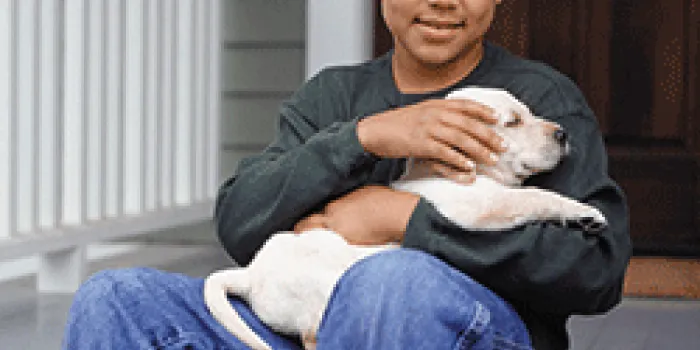Making a good match
Posted
Updated
Research shows that owning a pet can boost your mental and physical health. And for families who are managing a bleeding disorder, a pet can provide much-needed distractions and joy. However, parents should do their research before bringing home any new creatures.
The good news about pets
- Pets can help children’s health. First, walking a pet helps keep weight off. “Extra weight with a bleeding disorder puts extra strain on the joints, so you want to maintain a healthy body mass index (BMI),” says Laura Maynard McGinity, LMSW, a clinical social worker at the University of Michigan Pediatric Hemophilia and Coagulation Disorders Program in Ann Arbor. Besides providing companionship, if children are recovering at home from a bleed, surgery or an injury a pet can also help them laugh and find a way to play. “Kids can share secrets with their pets and receive unconditional love from them,” McGinity says.
- Pets help children deal with stress. In 2014, Tufts University researchers found that children of deployed soldiers who were strongly attached to a pet had better coping skills and showed lower symptoms of depression than those who did not have pets. “The pet becomes someone nonjudgmental who is always in their corner, providing comfort and support,” says coauthor Megan Mueller, PhD. Another study, conducted in 2015 in Florence, Italy, found that the presence of a dog reduces pain and distress in children when they have blood drawn.
- Pets teach responsibility. Giving children age-appropriate chores for their pet, such as feeding, cleaning and grooming, can help them understand what it means to be responsible for the well-being of another. The American Academy of Child & Adolescent Psychiatry states on its website: “Pets provide lessons about life; reproduction, birth, illnesses, accidents, death, and bereavement.” And because pets require care every day, kids benefit from consistent routines.
Decisions, decisions
To make the most successful match between pet and family, do your homework before you adopt. Ask yourself these questions, says McGinity:
- The pet’s size. How big is the pet compared to the child? Avoid choosing one that is so large or energetic that it can knock the child down. If you’re picking out a puppy, ask how large it will become.
- Your child’s developmental age. Can she care for the pet? Is he old enough to be taught how to behave correctly with the animal—no pulling, grabbing or hitting?
- Your schedule. How much time will the animal spend by itself? Caged pets like gerbils or reptiles can go for longer periods on their own. Dogs and cats need social interaction, as well as access to food, water and bathroom breaks.
- Your resources. Do you have the time and finances to pay for vet bills, train your pet or get a pet sitter, if needed? Training for uncaged animals is an important way to ensure pets know how to behave around people, especially your child.
Pets provide valuable companionship and promote caring, compassionate relationships. Do your homework to ensure your family and your pet-to-be are a good match.

